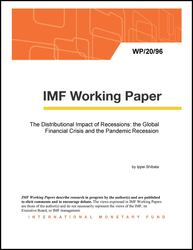
The Distributional Impact of Recessions: the Global Financial Crisis and the Pandemic Recession
The Distributional Impact of Recessions: the Global Financial Crisis and the Pandemic Recession
READ MORE...
Volume/Issue:
Volume 2020
Issue 096
Publication date: June 2020
ISBN: 9781513546759
$18.00
Add to Cart by clicking price of the language and format you'd like to purchase
Available Languages and Formats
| English |
Prices in red indicate formats that are not yet available but are forthcoming.
Topics covered in this book
This title contains information about the following subjects.
Click on a subject if you would like to see other titles with the same subjects.
Labor , Economics- Macroeconomics , WP , recession , Pandemic recession , Labor Market Dynamics , Current Population Survey , COVID-19 Pandemic , Gross Worker Flows , Distributional Impact , separation probability , wage quantile , separation rate , log employment , defining job separation probability , recession in terms , workable job , job characteristic , Pandemic x wage quantile , employment statistics , job prospect , Global financial crisis of 2008-2009 , Employment , Unemployment rate , Wages , Global , COVID-19
Summary
Using the U.S. Current Population Survey data, this paper compares the distributional impacts of the Pandemic Crisis and those of the Global Financial Crisis in terms of (i) worker characteristics, (ii) job characteristics–“social” (where individuals interact to consume goods), “teleworkable” (where individuals have the option of working at home), and “essential” jobs (which were not subject to government mandated shut-downs during the recent recession), and (iii) wage distributions. We find that young and less educated workers have always been affected more in recessions, while women and Hispanics were more severely affected during the Pandemic Recession. Surprisingly, teleworkable, social and essential jobs have been historically less cyclical. This historical acyclicality of teleworkable occupations is attributable to its higher share of skilled workers. Unlike during the Global Financial Crisis, however, employment in social industries fell more whereas employment in teleworkable and essential jobs fell less during the Pandemic Crisis. Lastly, during both recessions, workers at low-income earnings have suffered more than top-income earners, suggesting a significant distributional impact of the two recessions.
Copyright © 2010 - 2024
Powered by:
AIDC



